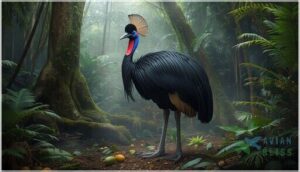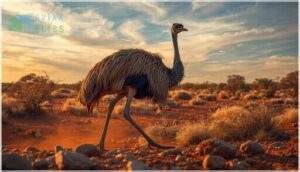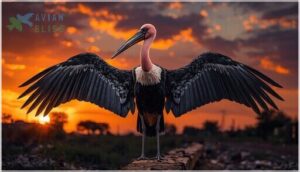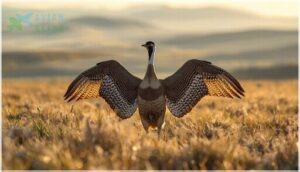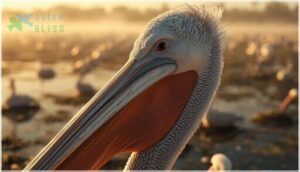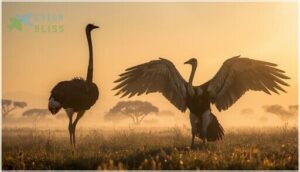This site is supported by our readers. We may earn a commission, at no cost to you, if you purchase through links.
When you picture the biggest birds on Earth, you might imagine creatures soaring across vast skies—but the true giants rarely leave the ground. The common ostrich towers at 9 feet tall and tips the scales at nearly 300 pounds, making it larger than many adult humans.
These massive species evolved striking adaptations after losing their ability to fly: cassowaries developed knife-like claws and bony crowns, emus engineered respiratory systems for marathon running, and penguins traded wings for flippers to dominate icy waters.
From Africa’s savannas to Antarctica’s ice sheets, the world’s largest birds showcase how size becomes an advantage when you’re built for your environment rather than the air. Understanding these giants reveals not just record-breaking measurements, but the surprising ways evolution shapes life at the extremes of avian biology.
Table Of Contents
- Key Takeaways
- Top 10 Biggest Birds in The World
- Heaviest and Tallest Bird Species
- Largest Flying and Flightless Birds
- Unique Features of The World’s Largest Birds
- Top 3 Books on Bird Evolution and Species
- Frequently Asked Questions (FAQs)
- What are the world’s biggest birds?
- What is the heaviest bird in the world?
- What is the largest flying bird?
- Which bird has the biggest wingspans?
- What is the top 10 biggest bird?
- What is the largest flying bird in the world?
- What is the largest bird ever recorded?
- What is the human sized bird?
- Which bird has the largest egg?
- Whats the biggest bird that can fly?
- Conclusion
Key Takeaways
- The common ostrich dominates as Earth’s largest bird at 9 feet tall and up to 300 pounds, while the wandering albatross claims the wingspan record at 12 feet among flying species.
- Flightless giants evolved specialized adaptations like cassowaries’ knife-like claws and heat-radiating casques, ostriches’ 43 mph sprint speed with wing air-rudders, and emperor penguins’ extreme cold resistance through dense feather insulation and huddling behavior.
- Sexual dimorphism plays a major role in weight distribution across large bird species, with male ostriches outweighing females significantly while female emus carry more mass than males.
- Conservation challenges threaten several species, including emperor penguins facing a 22% population decline from sea-ice loss and great bustards showing two-thirds of West African colonies disappearing despite stable global numbers.
Top 10 Biggest Birds in The World
When you think about the biggest birds on Earth, you’re probably picturing towering, ground-dwelling giants or massive ocean dwellers with impressive wingspans. Size in birds isn’t just about height—it’s also about weight, bulk, and overall presence.
Let’s explore the ten largest bird species that dominate their habitats around the world.
Common Ostrich
The common ostrich claims the title of the largest bird species on Earth, with males standing up to 9 feet tall and weighing 220 to 290 pounds. You’ll find these flightless birds across Africa’s savannas and grasslands, where their impressive ostrich speed reaches 43 mph.
They lay eggs measuring 15 cm long—the biggest of any bird—and can live over 40 years in the wild. Their large eyes give them exceptional visual acuity, allowing them to spot predators from afar.
Somali Ostrich
The Somali ostrich ranks second among flightless birds, with males reaching 9 feet tall and weighing 220–287 pounds. You’ll spot these Africa natives across the Horn’s arid bushlands, where habitat threats from agriculture and poaching challenge their conservation status as Vulnerable. Their breeding habits involve communal nesting, while dietary needs focus on browsing leaves rather than grazing, reflecting adaptations to sparse vegetation. They’re primarily found in the Horn of Africa.
Key Physical Traits:
- Males weigh 220–287 pounds; females 198–242 pounds
- Height ranges 6.6–9.8 feet
- Males display bright blue skin during breeding season
- 15% weight dimorphism between sexes
- Browsing specialists rather than grazers
Southern Cassowary
The Southern Cassowary stands third among the largest birds, with females reaching 175 pounds and 5.8 feet tall. These flightless birds inhabit the lowland rainforests of New Guinea and northeastern Australia, where their black feathers and striking blue-red neck coloration make them distinctive.
Their ecological role in seed dispersal is essential for rainforest regeneration. Males incubate eggs while defending territories spanning up to 100 hectares. Habitat conservation efforts address fragmentation threats.
Emu
Australia’s emu takes fourth place among the world’s largest birds, standing up to 6.3 feet tall and weighing around 110 to 121 pounds. You’ll find these flightless birds across mainland Australian habitats, from eucalyptus forests to desert shrublands, where their long legs power speeds up to 31 mph.
What makes emu behavior fascinating:
- Males alone incubate 5 to 24 dark-green eggs for eight weeks, rarely eating during this period
- They swallow stones weighing up to 1.6 pounds to grind food in their gizzards
- Chicks display striped camouflage patterns in black, brown, and cream
- Their omnivorous diet includes fruits, insects, and even small animals
- During droughts, they’ll travel hundreds of kilometers, losing half their body weight
Bird conservation efforts have stabilized emu populations at roughly 630,000 to 725,000 individuals. Australian wildlife protections now safeguard these extraordinary flightless birds, though localized threats from habitat fragmentation and vehicle collisions persist in some regions.
Greater Rhea
South America’s Greater Rhea ranks fifth among the world’s largest birds, reaching heights up to 5 feet 7 inches and weighing 44 to 88 pounds. You’ll spot these flightless birds across Argentina’s grasslands and Brazil’s scrublands, where habitat conservation efforts protect their declining populations.
Males handle all nesting behaviors, incubating up to 30 eggs from multiple females. Their feather adaptations and bird socialization patterns support rhea migration across vast territories.
Emperor Penguin
The Emperor penguin claims sixth place among Earth’s largest birds, standing 97–115 cm tall and weighing 22–45 kg across seasons. You’ll find this notable Antarctic breeding specialist enduring temperatures as low as -50°C while raising chicks during winter’s harshest months.
- Males lose 26% body weight during two-month incubation fasts
- Diving adaptations enable 535-meter depths, 20-minute submersions
- Climate impacts drove 22% population decline between 2009–2023
Conservation status monitoring reveals troubling trends, as three consecutive years of record-low sea-ice extent caused catastrophic breeding failures across multiple colonies.
King Penguin
Ranking seventh, King penguins reach 70–100 cm tall and weigh 9.3–18 kg, making them smaller than Emperor penguins but impressive in stature. You’ll spot these subantarctic specialists by their vivid orange plumage coloration on the head and chest, contrasting with sleek black and white bodies.
| Breeding Parameter | King Penguin Value |
|---|---|
| Breeding cycle duration | 14–16 months |
| Chick fledging success | 500–700/year (Falklands) |
| Population trends | 1.6–1.7 million pairs (stable) |
Diet composition shifts seasonally—80% fish annually, dropping to 30% during winter when lanternfish availability decreases across subantarctic islands.
Marabou Stork
At eighth place, the marabou stork stands up to 152 cm tall and weighs 4.5–9 kg, with wingspans reaching 287 cm. You’ll recognize these scavengers by their naked pink heads and massive bills (26.4–35 cm).
Their feeding habits show striking urban adaptation, foraging at landfills up to 55 km from nests.
Despite a stable global conservation status, breeding trends reveal concerning declines—nearly two-thirds of West African colonies have disappeared.
Great Bustard
At ninth place, the great bustard showcases the most extreme sexual dimorphism among bird species—males weigh 5.8–21 kg compared to females at just 3.5–5 kg.
You’ll find these endangered birds in open grasslands across Europe to Asia, where males perform elaborate lek behavior displays.
Despite wingspans reaching 2.7 meters, their flight capabilities support some of the heaviest verified weights for flying birds worldwide.
Dalmatian Pelican
Rounding out our top ten, you’ll encounter the Dalmatian pelican—a silvery giant with a wingspan stretching up to 3.5 meters and weighing as much as 15 kg, making it among the largest flying birds globally.
Key characteristics include:
- Unique morphology: 37–45 cm bill with orange-red breeding pouch
- Habitat threats: Power line collisions and avian influenza
- Population trends: Under 20,000 individuals remain worldwide
- Breeding habits: Monogamous pairs nest colonially on platforms
- Pelican conservation: Artificial nesting sites improve survival rates
Heaviest and Tallest Bird Species
When you’re talking about the biggest birds, you need to separate heaviest from tallest, because they don’t always overlap the way you’d expect. Some birds pack on serious weight while staying relatively short, while others tower above the rest without tipping the scales as much.
Let’s break down which species claim the records for pure mass, maximum height, and the most impressive size-weight combinations on the planet.
Heaviest Birds by Average Weight
When you compare the heaviest bird species by average weight, the common ostrich dominates at 104 kg, followed by the Somali ostrich at 90 kg. Sexual dimorphism plays a role—males generally outweigh females in ostriches, while female emus carry more mass.
These weight adaptations reflect habitat impact and metabolic rates, with conservation status often tied to how well largest bird species maintain their maximum weight in changing environments.
Tallest Birds by Maximum Height
While weight tells part of the story, you’ll find height reveals another dimension of bird size. The common ostrich towers at 2.8 meters (9.2 feet), claiming the crown as Earth’s tallest bird. Somali ostriches reach 2 meters, followed by emus at 1.9 meters and southern cassowaries at 1.7 meters—that distinctive cassowary casque adding extra vertical drama.
Among flying birds, the sarus crane stands tallest at 1.8 meters.
Size and Weight Records Among Birds
When you examine bird size and weight records, the numbers get impressive fast. The common ostrich holds both titles—its maximum verified weight reached 346 pounds, while wingspan champions like the wandering albatross stretch 12.1 feet. Among flying species, the kori bustard tops the scales at 42 pounds. These measurements help you appreciate how varied “biggest” really means across different bird families.
Largest Flying and Flightless Birds
Birds have evolved along two dramatically different paths regarding size. Some giants dominate the skies with massive wingspans, while others traded flight for sheer bulk and power on the ground.
Let’s compare the largest species in each category and explore what makes flightless birds so uniquely adapted to life without wings.
Largest Flying Birds (by Wingspan and Weight)
The Wandering albatross reigns as the largest flying bird by wingspan, stretching up to 3.7 meters across. Wingspan comparison reveals the Dalmatian pelican follows closely at 3.2 meters, while weight measures show the Kori bustard as the heaviest flier at 20 kg.
These giants master thermal soaring techniques, with some species reaching flight altitudes over 5,486 meters during their impressive migration patterns.
Largest Flightless Birds (by Height and Mass)
You’ll find that size evolution among flightless birds reaches its peak with the common ostrich, standing up to 2.75 meters tall and weighing 156.8 kg. Weight distribution and dimorphism factors vary across the largest bird species:
- Ostriches dominate both height and mass records
- Southern cassowaries reach 85 kg despite habitat influence
- Emus average 1.9 meters, showing significant sexual differences
- Greater rheas top out at 40 kg
- Conservation status remains stable for most species
Adaptations of Flightless Giants
When flightless birds abandoned flight, they gained something extraordinary—a complete redesign of their anatomy. You’ll notice skeletal modifications like reduced keel bones and leg muscles comprising over 42% of body mass in ostriches.
These largest bird species evolved thermoregulation strategies, including 30% body fat in emperor penguins, while locomotion adaptations enable cassowaries to kick with forces exceeding 2,000 newtons.
The largest flightless birds evolved extreme adaptations—emperor penguins store 30% body fat for insulation, while cassowaries deliver kicks exceeding 2,000 newtons
Unique Features of The World’s Largest Birds
The world’s largest birds aren’t just impressive because of their size—they’ve evolved some truly striking features that help them survive in their specific environments. From defensive structures to thermal adaptations, each species has developed unique traits that set it apart.
Let’s explore five fascinating features that make these giants stand out in the avian world.
Ostrich’s Speed and Air-Rudders
Ostriches may be flightless bird adaptations champions, but they’re built for speed. You’ll see them hit 43 mph in short bursts, maintaining 37 mph for up to 40 minutes.
Their running biomechanics rely on powerful limb structure and elastic tendons that recycle energy with each stride. Air-rudder function comes from those large wings, deployed mid-sprint for sharp turns and stability.
These speed adaptations have even inspired evolutionary inspiration in robotics and prosthetics design.
Cassowary’s Casque
The southern cassowary’s helmet-like casque is a wonder of avian anatomy, built for more than show. Here’s what makes it fascinating:
- Thermal radiator: Offloads excess heat at high temperatures through surface vasculature
- Honeycomb structure: Lightweight yet strong, with dense bone and air-filled chambers
- Growth timeline: Develops from 1.5 months, accelerating until sexual maturity
- Species variation: Southern cassowary species possess the largest, reaching 7 inches tall
- Heat regulation: Restricts loss in cold through vasoconstriction
This casque evolution reflects distinct regional adaptations across cassowary populations.
Marabou Stork’s Bald Head
The marabou stork’s bald head isn’t just for show—it’s a multi-purpose adaptation you’ll find fascinating. This naked skin helps large birds manage heat through thermoregulation while keeping clean during messy scavenging meals. Here’s how this feature benefits the species:
| Adaptation | Function |
|---|---|
| Heat dissipation | Exposed skin releases excess body heat in tropical climates |
| Hygiene maintenance | Prevents blood and debris accumulation during carrion feeding |
| Parasite resistance | Limits anchor sites for external parasites |
| Social signaling | Facilitates visible color changes during breeding displays |
| Evolutionary traits | Convergent adaptation shared with vultures and other scavengers |
These bird characteristics demonstrate how avian species evolve specialized features matching their ecological niche.
Dalmatian Pelican’s Bill Pouch
The Dalmatian Pelican’s bill pouch operates like an expandable fishing net, stretching to hold approximately 3 gallons of water during prey capture. This exceptional aquatic adaptation fulfills multiple functions:
- Bulk feeding – scooping up to 4 pounds of fish daily
- Thermal regulation – cooling the bird through evaporative heat loss
- Pouch flexibility – elastic gular skin expands threefold for maximum capture efficiency
These bird characteristics make large birds exceptionally efficient hunters.
Emperor Penguin’s Cold Adaptations
While pouches help pelicans manage tropical heat, you’ll find Emperor Penguins tackle the opposite extreme through impressive cold resistance. Their feather insulation provides over 80% of body protection, layered four times denser than other penguin species.
Huddling behavior and metabolic adaptation let these flightless bird characteristics shine—thermoregulation systems and counter-current heat exchange preserve core warmth even when Antarctic winds hit −47–C, showcasing exceptional bird adaptations and evolution.
Top 3 Books on Bird Evolution and Species
If you’re curious about how these giants came to be, a few standout books can really deepen your understanding of bird evolution and diversity. Each one brings something different to the table, whether you’re after evolutionary theory, scientific discovery, or thorough field identification.
Here are three titles worth adding to your shelf.
1. How Birds Evolve Bird Evolution
If you want to understand how bird evolution really works, this book offers an extensive introduction to the topic. Written by a renowned evolutionary biologist, it traces avian ancestry back to nonavian dinosaurs, drawing on fossil evidence and genomic insights to explain how extinction events reshaped bird species.
You’ll explore adaptive radiation after the Cretaceous–Paleogene catastrophe, which wiped out most dinosaurs but allowed surviving bird lineages to diversify rapidly. The author uses natural selection principles and real-world examples to show how bird size, behavior, and traits evolved over millions of years.
2. Ascent of Birds Evolution and Science
If you’re ready to explore bird evolution through the lens of modern science, The Ascent of Birds builds on evolutionary principles with detailed chapters on speciation mechanisms.
You’ll trace lineages from Gondwana origins through extinction impacts that reshaped avian genomics. The author examines fossil records alongside molecular data, revealing how theropod dinosaurs gave rise to today’s birds.
Each chapter unpacks a distinct evolutionary narrative—neoteny, dispersal, adaptive radiation—giving you a clearer picture of how over 10,000 species emerged from ancient survivors.
3. RSPB Complete Birds of Britain Europe
If you prefer hands-on species identification over theory, the RSPB Complete Birds of Britain Europe gives you 330 full-page profiles with distribution mapping, behavioural insights, and over 500 photographs. You’ll compare bird physical properties—length, wingspan, weight—across entries, and visual resources include flight illustrations that highlight plumage variations.
The guide’s colour-coded maps track resident and migratory movements, while a free audio app adds birdsong recordings. Published in 2020, it covers avian diversity from common garden visitors to rare vagrants, making bird species comparison straightforward.
Frequently Asked Questions (FAQs)
What are the world’s biggest birds?
The world’s largest birds include the common ostrich, which towers at 8 meters tall and weighs up to 156 kilograms, alongside other flightless giants like cassowaries, emus, and penguins.
What is the heaviest bird in the world?
The common ostrich holds the record as the heaviest bird, with males averaging 104 kg and some reaching up to 8 kg, making it the undisputed champion among flightless giants.
What is the largest flying bird?
You might think the heaviest flying birds would have the largest wingspans, but that’s not the case. The wandering albatross holds the wingspan record at 12 feet, while the Kori Bustard tops weight at 41 pounds.
Which bird has the biggest wingspans?
The wandering albatross holds the record for wingspan among living bird species, reaching up to 12 feet. Extinct Pelagornis sandersi had the largest wingspan ever, spanning an astonishing 20–24 feet.
What is the top 10 biggest bird?
The largest birds by size comparison combine weight distribution, bird height, and bird wingspan. Conservation status varies across these large birds, whose evolutionary advantages reflect habitat influence—from ostriches to penguins.
What is the largest flying bird in the world?
The wandering albatross holds the wingspan record among flying birds, averaging 1 meters and reaching up to 7 meters. These birds glide effortlessly across oceans with minimal wing flapping.
What is the largest bird ever recorded?
To put it in perspective, Vorombe titan—an elephant bird from Madagascar—tips the scales as the largest bird ever recorded, reaching 860 kilograms and towering 3 meters tall before extinction.
What is the human sized bird?
You’re looking at ostriches and emus—both tower around human height or taller. These ratites showcase flightlessness factors like dense bones and powerful legs.
Cassowaries and greater rheas also match our stature, demonstrating striking human-sized adaptations.
Which bird has the largest egg?
The ostrich lays the largest egg among living bird species, measuring about 15 cm long and weighing up to 6 kg. Each egg equals roughly 24 chicken eggs in volume.
Whats the biggest bird that can fly?
The Kori Bustard and Great Bustard claim the title of heaviest fliers, with males reaching up to 40 kg. The Wandering Albatross, however, dominates bird wingspans at an impressive 5 meters.
Conclusion
Regarding the biggest birds, the sky’s hardly the limit—most never bother reaching it. From ostriches sprinting across African plains to penguins torpedoing through Antarctic seas, these giants prove that evolution doesn’t always favor flight.
Their towering frames, specialized anatomy, and extreme adaptations reveal nature’s creative solutions to survival at scale.
Understanding these extraordinary species isn’t just about appreciating records; it’s recognizing how life flourishes when form follows function rather than tradition.
- https://www.britannica.com/animal/marabou-bird
- https://www.clevelandzoosociety.org/z/2024/01/25/ask-the-expert-why-is-the-marabou-stork-bald
- https://nationalzoo.si.edu/animals/emu
- https://en.wikipedia.org/wiki/Andean_condor
- https://ultimatekilimanjaro.com/the-25-most-interesting-extinct-animals-with-photos/




